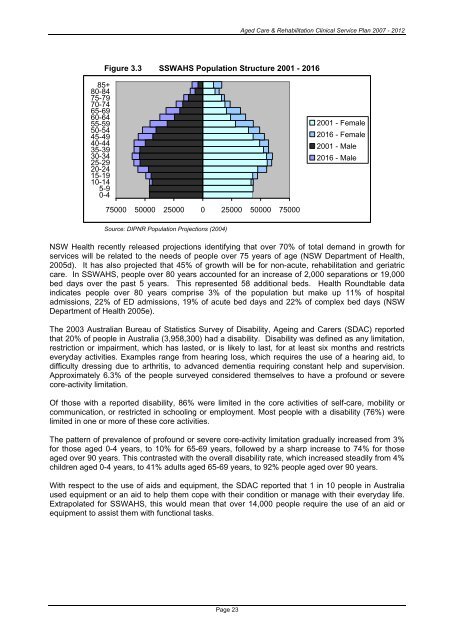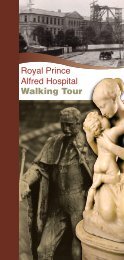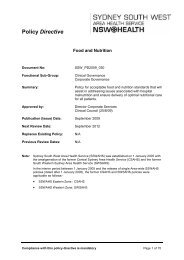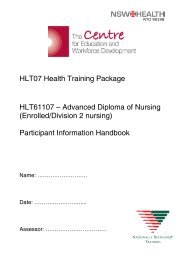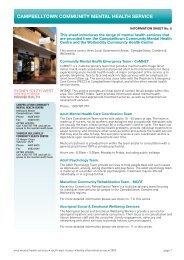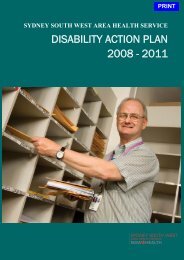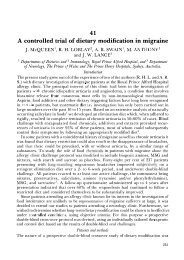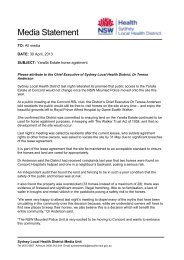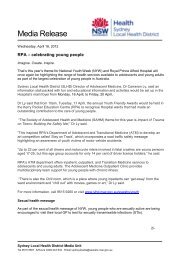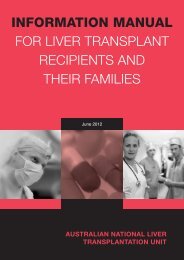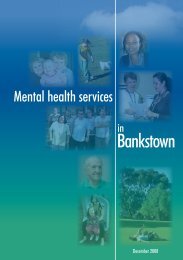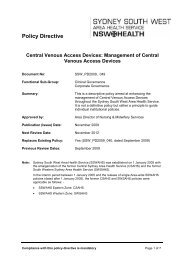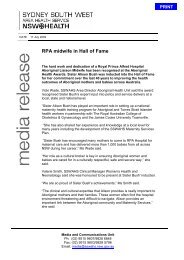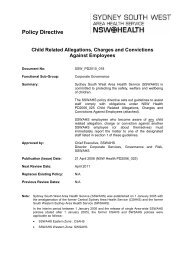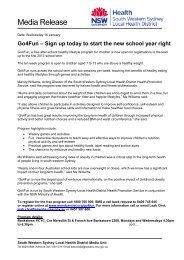Aged Care & Rehabilitation Clinical Services Plan 2007 – 2012
Aged Care & Rehabilitation Clinical Services Plan 2007 – 2012
Aged Care & Rehabilitation Clinical Services Plan 2007 – 2012
Create successful ePaper yourself
Turn your PDF publications into a flip-book with our unique Google optimized e-Paper software.
<strong>Aged</strong> <strong>Care</strong> & <strong>Rehabilitation</strong> <strong>Clinical</strong> Service <strong>Plan</strong> <strong>2007</strong> - <strong>2012</strong>Figure 3.3 SSWAHS Population Structure 2001 - 201685+80-8475-7970-7465-6960-6455-5950-5445-4940-4435-3930-3425-2920-2415-1910-145-90-42001 - Female2016 - Female2001 - Male2016 - Male75000 50000 25000 0 25000 50000 75000Source: DIPNR Population Projections (2004)NSW Health recently released projections identifying that over 70% of total demand in growth forservices will be related to the needs of people over 75 years of age (NSW Department of Health,2005d). It has also projected that 45% of growth will be for non-acute, rehabilitation and geriatriccare. In SSWAHS, people over 80 years accounted for an increase of 2,000 separations or 19,000bed days over the past 5 years. This represented 58 additional beds. Health Roundtable dataindicates people over 80 years comprise 3% of the population but make up 11% of hospitaladmissions, 22% of ED admissions, 19% of acute bed days and 22% of complex bed days (NSWDepartment of Health 2005e).The 2003 Australian Bureau of Statistics Survey of Disability, Ageing and <strong>Care</strong>rs (SDAC) reportedthat 20% of people in Australia (3,958,300) had a disability. Disability was defined as any limitation,restriction or impairment, which has lasted, or is likely to last, for at least six months and restrictseveryday activities. Examples range from hearing loss, which requires the use of a hearing aid, todifficulty dressing due to arthritis, to advanced dementia requiring constant help and supervision.Approximately 6.3% of the people surveyed considered themselves to have a profound or severecore-activity limitation.Of those with a reported disability, 86% were limited in the core activities of self-care, mobility orcommunication, or restricted in schooling or employment. Most people with a disability (76%) werelimited in one or more of these core activities.The pattern of prevalence of profound or severe core-activity limitation gradually increased from 3%for those aged 0-4 years, to 10% for 65-69 years, followed by a sharp increase to 74% for thoseaged over 90 years. This contrasted with the overall disability rate, which increased steadily from 4%children aged 0-4 years, to 41% adults aged 65-69 years, to 92% people aged over 90 years.With respect to the use of aids and equipment, the SDAC reported that 1 in 10 people in Australiaused equipment or an aid to help them cope with their condition or manage with their everyday life.Extrapolated for SSWAHS, this would mean that over 14,000 people require the use of an aid orequipment to assist them with functional tasks.Page 23


